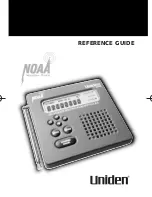
1
About Your Radio
Traditional weather radios receive NOAA's weather broadcast (usually
within a 50-mile radius) then sound an alarm of any emergency code
which was transmitted along with the broadcast. This means that people
who live outside an affected area are often alerted even when their area
is not affected, causing many of them to ignore potentially real
emergency/weather warnings that can save lives.
In 1994, the National Oceanic and Atmospheric Administration (NOAA)
began broadcasting coded signals called FIPS (Federal Information
Processing System) codes along with their standard weather broadcasts
from stations in your area. These codes identify an emergency and the
specific geographic area (such as a county) affected by the emergency.
The WX500 was developed with the S.A.M.E. (Specific Area Message
Encoding) technology. This allows your radio to receive, interpret,
and display the information about the codes so you can determine
if the emergency might affect your area. Only S.A.M.E. compatible
emergency/weather radios are able to take advantage of this new
technology.
Each FIPS code identifies a specific geographic area (defined by the
National Weather Service), so your radio sounds an alert only when
an emergency/weather emergency is declared in those locations.
This helps you more efficiently track the emergency/weather conditions
in and around your area.
INTRODUCTION
WX500 web OM final.qxd 07/15/2002 4:30 PM Page 1
Содержание WX500
Страница 1: ...REFERENCE GUIDE ...





































